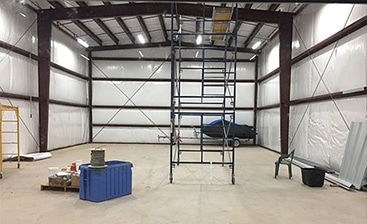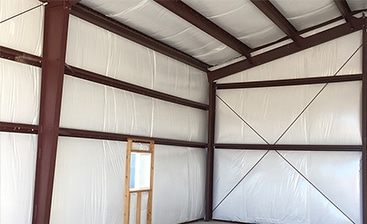What Insulation Type Is Most Suitable for Metal Buildings?



In recent years, the importance of insulation in metal building structures has been recognized and emphasized by building codes. Insulation is no longer an afterthought but a crucial aspect of creating energy-efficient and comfortable workspaces. With advancements in insulation technology, metal building systems have become efficient, low-maintenance, and sustainable options for construction.
The following guide will explore the different metal building insulation options and their potential benefits.
Why Insulate a Metal Building?
Insulating a metal building provides numerous benefits, making it an essential step in the construction process. Here are some of the main reasons why you should consider insulating your metal building:
- Energy Efficiency: Insulation helps to regulate temperature and reduce heat transfer, leading to lower energy consumption for heating and cooling your metal building, allowing you to reduce your energy costs.
- Comfort: Proper insulation creates a comfortable indoor environment by maintaining a consistent temperature and reducing noise pollution.
- Condensation Control: Without insulation, metal buildings are vulnerable to condensation buildup, which can lead to structural damage and mold growth. Insulation helps to prevent this issue by controlling the temperature of the building’s interior surfaces.
Types of Metal Building Insulation for Walls
Metal building insulation is available in a variety of materials and forms, each with its unique properties and benefits. The most commonly used types of insulation for metal buildings include:
Fibreglass Solutions
Fibreglass insulation is made from tiny glass fibres that are spun and woven together to create a material with excellent thermal insulating properties. It is commonly used in metal buildings due to its affordability, durability, and ease of installation.
Advantages:
- High R-value (thermal resistance), which measures the effectiveness of an insulating material.
- Fire resistance makes it a safer option for metal buildings.
- Excellent sound absorption properties, reducing noise pollution and creating a quieter indoor environment.
Disadvantages:
- Can irritate the skin and respiratory system if not handled properly.
Standard Metal Building Blanket Insulation
Standard metal building blanket insulation is a type of insulation that consists of a flexible fibreglass blanket with facing materials on one or both sides. The facing materials provide additional protection against moisture and act as an air barrier, making this type of insulation ideal for metal buildings.
Advantages:
- Cost-effective due to its easy installation process.
- Superior thermal performance and noise reduction.
Disadvantages:
- Bulkier and less flexible than other types of insulation, making it challenging to install in tight spaces.
- The facing materials can be easily damaged during installation, reducing its effectiveness.
Filled (Girt) Cavity Systems
Filled cavity systems, also known as girt cavity systems, are a type of insulation that fills the space between the structural support members and the metal exterior walls. This method provides excellent thermal performance and is highly recommended for areas with extreme temperature variations.
Advantages:
- Provides continuous insulation without gaps or voids.
- Can be used in both new construction and retrofit applications.
- Highly effective in controlling moisture and preventing condensation buildup.
Disadvantages:
- High cost because they require specialized equipment and skilled labour for installation.
Fabric Liner System
Fabric liner systems are a type of insulation that consists of an interior fabric layer and an exterior facing material, typically made of metal or PVC. This method is commonly used in agricultural and commercial buildings due to its cost-effectiveness and ease of installation.
Advantages:
- Versatility, as they can be easily installed on curved surfaces.
- Lightweight and flexible, making it suitable for tight spaces.
- Provides excellent thermal performance and reduces noise pollution.
Disadvantages:
- They require additional support to prevent sagging.
Rigid Board Solutions
Rigid board insulation is made from polyisocyanurate or polystyrene foam and is rigid, making it ideal for metal building walls. It offers superior thermal performance and can be used in both new construction and retrofit applications.
Advantages:
- High R-value per inch, providing maximum thermal resistance in limited space.
- Moisture-resistant, making it a durable option for metal buildings.
- Easy to install and does not require specialized equipment.
Disadvantages:
- Higher cost compared to other types of insulation.
Insulated Metal Panels
Insulated metal panels are a type of insulation that combines the exterior metal cladding and interior insulation into one panel. This method provides excellent thermal performance and is highly recommended for energy-efficient buildings.
Advantages:
- Ease of installation due to its all-in-one design.
- Superior thermal performance, reducing energy consumption and costs.
- Provides a durable and moisture-resistant exterior for the building.
Disadvantages:
- Limited design options, as they cannot be easily customized or altered once installed.
Standard Faced Fibreglass
Standard-faced fibreglass rolls are a type of insulation that comes in roll form with facing materials on one side. This method is commonly used in metal buildings due to its affordability and versatility.
Advantages:
- Cost-effective, making it an ideal option for large metal buildings.
- Easy to install, especially in open-wall and attic areas.
Disadvantages:
- Less effective in controlling moisture compared to other types of insulation.
- Require additional protective measures against pests.
Spray Foam Insulation
Spray foam insulation is a type of insulation that is applied as a liquid and expands to fill the desired space, creating an air-tight seal. It offers excellent thermal and moisture control performance and is commonly used in metal buildings.
Advantages:
- Provides superior coverage and sealing compared to other types of insulation.
- Offers a high R-value per inch, making it efficient in limited space.
- Provides long-term energy savings and durability.
Disadvantages:
- Higher upfront cost.
Why Rely on Toro’s Roof & Wall Insulation System?
We understand the importance of proper insulation in metal buildings. That’s why we offer a wide range of high-quality insulation options to meet your specific building needs. We provide insulation packages for the following types of metal buildings:
- For Arch Style: We offer Polypropylene and foil-facing insulation packages for arch-style buildings.
- For Straight Wall: We offer fibreglass insulation systems for straight-wall buildings.
We are a Trusted Name in the Metal Building Industry
At Toro, we pride ourselves on our expertise and exceptional customer service. We have been a trusted name in the metal building industry for over 30 years, offering high-quality steel buildings and insulation systems to clients across North America. Contact us online or call 1-877-870-8676 to learn more about our metal building insulation options. Also, check out our Sister Company Future Buildings for other informative content here.
Related Post





